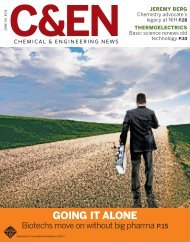February 27, 2012 - IMM@BUCT
February 27, 2012 - IMM@BUCT
February 27, 2012 - IMM@BUCT
You also want an ePaper? Increase the reach of your titles
YUMPU automatically turns print PDFs into web optimized ePapers that Google loves.
news of the week<br />
FEBRUARY <strong>27</strong>, <strong>2012</strong> EDITED BY WILLIAM G. SCHULZ & SOPHIA L. CAI<br />
DIOXINS,<br />
ASSESSED AT LAST<br />
POLLUTION: After years of study,<br />
EPA sets safe level of exposure<br />
to the most toxic congener<br />
AFTER 21 YEARS of contentious scientific analysis,<br />
the Environmental Protection Agency has<br />
established a safe level of exposure to the most<br />
toxic form of dioxin.<br />
EPA set a safe daily dose of 0.7 picograms of<br />
2,3,7,8-tetrachlorodibenzo- p -dioxin (TCDD) per kilogram<br />
of body weight. TCDD is the most potent congener<br />
of the dioxins, which generally are unintentional<br />
by-products of manufacturing processes involving<br />
chlorine and burning of biomass or waste.<br />
Eventually, this defined level of safe exposure will<br />
affect the degree—and cost—of cleanups of soil and of<br />
industrial air and water releases polluted with dioxins.<br />
This category of chemicals consists of chlorinated<br />
dioxins and furans and certain polychlorinated biphenyls.<br />
These substances can trigger similar adverse<br />
health effects, but their potencies vary.<br />
The exact regulatory impacts of the agency’s determination<br />
, which was released on Feb. 17, are as yet uncertain.<br />
EPA’s new level “will serve as the cornerstone<br />
of the agency’s initiatives to protect public health from<br />
chemical contaminants and provide the necessary<br />
guidance to states and public health agencies to minimize<br />
dioxin exposure,” says Olga Naidenko, a senior<br />
scientist with the Environmental Working Group, an<br />
activist group.<br />
The American Chemistry Council, an industry organization<br />
that has invested much time and energy in<br />
influencing EPA’s work on this assessment, calls the<br />
agency’s conclusions “flawed.”<br />
Lois Marie Gibbs, executive<br />
director of the Center for Health,<br />
Environment & Justice, an environmental<br />
group that has focused<br />
on dioxin issues for years, hails<br />
the long-awaited completion of<br />
the agency’s effort. “The American people,” she says,<br />
“won a major victory against the chemical industry,<br />
which has been working behind closed doors for decades<br />
to hide and distort the truth about the dangers of<br />
dioxin.”<br />
Data in EPA’s annual Toxics Release Inventory indicate<br />
that U.S. industry has slashed its releases of dioxins<br />
in the past two decades (C&EN, Feb. 6, page 26).<br />
Cl<br />
Cl<br />
O<br />
O<br />
2,3,7,8-Tetrachlorodibenzo-p-dioxin<br />
Backyard waste burning is the major source of dioxins<br />
in the U.S. today.<br />
The EPA limit is based on two studies. One found<br />
adverse reproductive effects in men exposed to TCDD<br />
as boys. The other found hormonal effects in infants<br />
born to mothers who had high levels of exposure.<br />
People are exposed to dioxins mainly by eating<br />
meat, poultry, dairy products, fish, or eggs. However,<br />
EPA claims that “most Americans have only low-level<br />
exposure to dioxins,” adding that this “does not pose a<br />
significant health risk.”<br />
The agency’s document examines health effects<br />
other than cancer from TCDD exposure. They include<br />
chloracne, a severe skin disease producing acne-like<br />
WWW.CEN-ONLINE.ORG 5 FEBRUARY <strong>27</strong>, <strong>2012</strong><br />
Cl<br />
Cl<br />
lesions; developmental and reproductive effects; damage<br />
to the immune system; hormonal disruption; and,<br />
possibly, mild liver damage. The agency is still working<br />
on a second document focusing on cancer hazards<br />
of TCDD.<br />
The assessment, which EPA launched in 1991 to<br />
update a 1985 document describing<br />
the cancer hazards of<br />
TCDD, has faced many delays.<br />
Throughout the years, polluting<br />
industries—including chemical<br />
companies—have faulted EPA’s<br />
work. Community and public<br />
health groups, meanwhile, have pressured the agency<br />
to finish the review.<br />
“After 21 years in the making, the dioxin assessment<br />
is in the hands of the American people,” says Paul T.<br />
Anastas, who oversaw release of the report on his final<br />
day as EPA’s top scientist (C&EN, Jan. 16, page 9).<br />
“I quite honestly never thought this report would<br />
ever see the light of day,” Gibbs says. — CHERYL HOGUE<br />
Backyard burning<br />
of waste is now<br />
the main source of<br />
dioxins, according<br />
to EPA.<br />
SHUTTERSTOCK

















